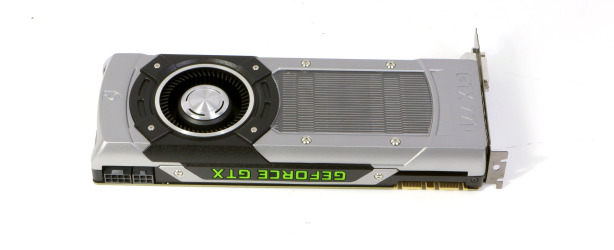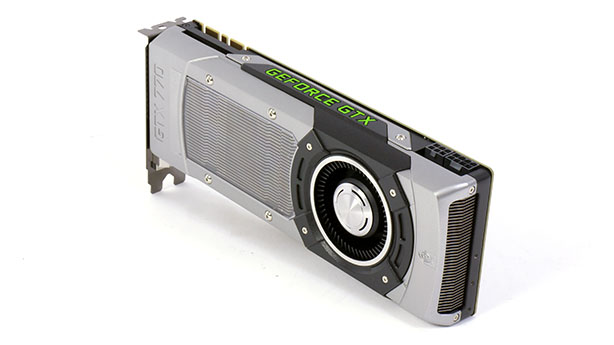
Performance Analysis
For those hoping the GTX 770 may be to the GTX 780 what that card is to the GTX Titan, in terms of performance, you’re likely to be disappointed. Instead, as the specs suggest, this card is a fairly big step down in performance, and only a small increase over the GTX 680. That said, it comfortably asserts itself as the top performer in its sector and marks a big step up from the GTX 670.
In BF3 the GTX 770 comes out on top of the GTX 680 and HD 7970 across the board, though the difference is consistently quite small. At 2,560 x 1,600 the GTX 770 gets 43fps, the GTX 680 gets 40fps and the HD 7970 gets 41fps. Compared to the GTX 670, though, the difference is more clearcut, with that card only achieving 36fps, making for a 19% improvement. Marking just how much of a step up the GTX 780 is, it gets 55fps in the same test.
It’s a similar story in Bioshock Infinite, though here the extra 1GB of memory of the HD 7970 means that card holds a comfortable advantage at the highest tested resolution. That said, with minimum/average framerates of 20/26fps, AMD’s card still struggles to make the game playable at 5,760 x 1,080 at Ultra Detail settings. Back to the GTX 770, though, and at 2,560 x 1,600 it delivers minimum 39fps which compares to 33fps for the GTX 670, 36fps for the GTX 680 and 37fps for the HD 7970. Again, the GTX 780 shows its might, producing 49fps.
Moving on to Crysis 3 and the GTX 770 again holds an advantage over all its main price competitors, delivering minimum 28fps at 2,560 x 1,600. This is a full 6fps advantage over the GTX 670, 3fps greater than the GTX 680 and 2fps above the HD 7970 3GB. Again 5,760 x 1,080 remains unplayable at these high detail settings, with a miserly 19fps minimum framerate, but that’s what lower detail settings are for.
In our GTX 780 review The Elder Scrolls V: Skyrim showed a lot of love for AMD’s graphics cards, but the GTX 770 has just managed to pull ahead again for Nvidia. It near enough matches the HD 7970 3GB across the board for minimum fps but comfortably holds an advantage in average fps, delivering 37fps min and 44fps average at 5,760 x 1,600, compared to the HD 7970’s 36fps and 43fps. Meanwhile the GTX 680 and GTX 670 deliver minimum framerates of 34fps and 32fps respectively. Again, the GTX 780 is a significant 30% faster than the GTX 770 here.
Unigine Valley actually shows the GTX 770 in the best light yet, scoring it a solid 10% above the GTX 680. Really telling the story, though, is our price/performance comparison based on the Unigine score. Thanks to its competitive pricing, it becomes clearly the best choice single-chip high-end graphics card at the moment.
As mentioned in out overclocking analysis, this card does run fairly toasty, hitting 80°C when under load, so we suspect that despite the merits of Nvidia's own cooler there's some headroom for exotic third-party coolers to give this card more overclocking potential.
As for power consumption, we measured 333W for the whole system under load, which as hinted by the card's TDP, is a little higher than you might hope given the performance difference between it and the GTX 780, which only draws 344W. As we've come to expect, though, idle power consumption is minimal, with this card registering the second lowest score in our current lineup of cards.
For those hoping the GTX 770 may be to the GTX 780 what that card is to the GTX Titan, in terms of performance, you’re likely to be disappointed. Instead, as the specs suggest, this card is a fairly big step down in performance, and only a small increase over the GTX 680. That said, it comfortably asserts itself as the top performer in its sector and marks a big step up from the GTX 670.
In BF3 the GTX 770 comes out on top of the GTX 680 and HD 7970 across the board, though the difference is consistently quite small. At 2,560 x 1,600 the GTX 770 gets 43fps, the GTX 680 gets 40fps and the HD 7970 gets 41fps. Compared to the GTX 670, though, the difference is more clearcut, with that card only achieving 36fps, making for a 19% improvement. Marking just how much of a step up the GTX 780 is, it gets 55fps in the same test.
It’s a similar story in Bioshock Infinite, though here the extra 1GB of memory of the HD 7970 means that card holds a comfortable advantage at the highest tested resolution. That said, with minimum/average framerates of 20/26fps, AMD’s card still struggles to make the game playable at 5,760 x 1,080 at Ultra Detail settings. Back to the GTX 770, though, and at 2,560 x 1,600 it delivers minimum 39fps which compares to 33fps for the GTX 670, 36fps for the GTX 680 and 37fps for the HD 7970. Again, the GTX 780 shows its might, producing 49fps.
Moving on to Crysis 3 and the GTX 770 again holds an advantage over all its main price competitors, delivering minimum 28fps at 2,560 x 1,600. This is a full 6fps advantage over the GTX 670, 3fps greater than the GTX 680 and 2fps above the HD 7970 3GB. Again 5,760 x 1,080 remains unplayable at these high detail settings, with a miserly 19fps minimum framerate, but that’s what lower detail settings are for.
In our GTX 780 review The Elder Scrolls V: Skyrim showed a lot of love for AMD’s graphics cards, but the GTX 770 has just managed to pull ahead again for Nvidia. It near enough matches the HD 7970 3GB across the board for minimum fps but comfortably holds an advantage in average fps, delivering 37fps min and 44fps average at 5,760 x 1,600, compared to the HD 7970’s 36fps and 43fps. Meanwhile the GTX 680 and GTX 670 deliver minimum framerates of 34fps and 32fps respectively. Again, the GTX 780 is a significant 30% faster than the GTX 770 here.
Unigine Valley actually shows the GTX 770 in the best light yet, scoring it a solid 10% above the GTX 680. Really telling the story, though, is our price/performance comparison based on the Unigine score. Thanks to its competitive pricing, it becomes clearly the best choice single-chip high-end graphics card at the moment.
As mentioned in out overclocking analysis, this card does run fairly toasty, hitting 80°C when under load, so we suspect that despite the merits of Nvidia's own cooler there's some headroom for exotic third-party coolers to give this card more overclocking potential.
As for power consumption, we measured 333W for the whole system under load, which as hinted by the card's TDP, is a little higher than you might hope given the performance difference between it and the GTX 780, which only draws 344W. As we've come to expect, though, idle power consumption is minimal, with this card registering the second lowest score in our current lineup of cards.

MSI MPG Velox 100R Chassis Review
October 14 2021 | 15:04










Want to comment? Please log in.